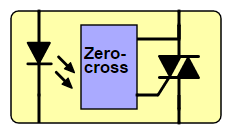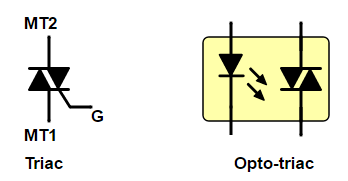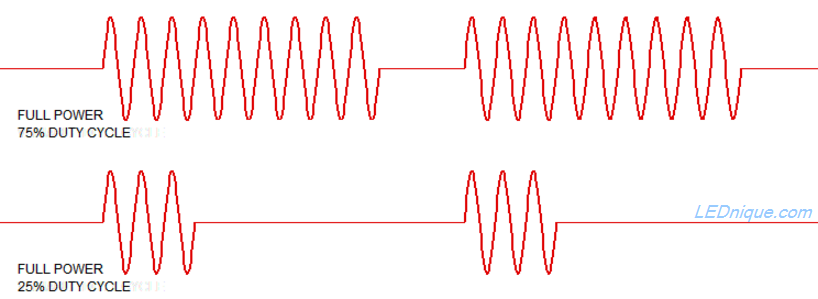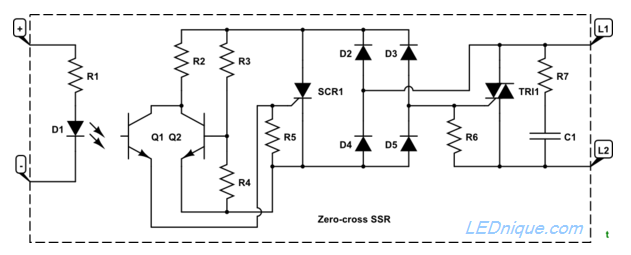Not all mains bulbs are dimmable. Those that are may require special dimmers to operate. In this article we explain how filament lamp dimmers work and some of the issues that can occur with LED lamps.

Incandescent lamp dimmer

Figure 1 shows a typical triac dimmer for incandescent lamps. Initially the triac, T1, is off.
- As the mains voltage rises C1 starts to charge up at a rate determined by the setting of R1; the lower the value of R1 the faster C1 charges up.
- When the voltage on C1 reaches about 20 V the DIAC breaks down and the charge in C1 flows into the trigger of T1 turning it on.
- One of the triac’s characteristics is that once triggered the triac will remain on until the current falls below the hold-on value which is close to zero (typically about 50 mA).
The result is a phase-angle controlled waveform as shown in Figure 2. If the triac is triggered late in the cycle (upper trace) the RMS voltage is low. If triggered early in the cycle (lower trace) the RMS voltage will be high. Note that the response is not linear.
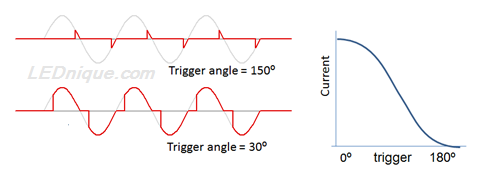
Fluorescent lights
As fluorescent lights need a minimum voltage, and both compact fluorescents and LEDs use electronics which rectifies the peak voltage provided, the conventional phase-angle control dimmer fails to dim them.
Ballast fluorescent lights would dim as the voltage reduced a little but then probably flicker and fail to light at all as the tube temperature dropped at further reduced voltage. For high frequency flourescent, CCFL and LED, it all depends on how the control circuitry has been designed.
LED filament bulbs
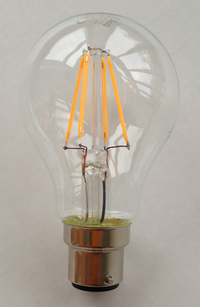
Generally these lamps should work well with dimmers as there are no onboard electronics. Read more about these in LED filament lamps.
Passive LED
Some of the cheap LED mains lamps use a capacative voltage dropper to reduce the voltage and limit the current to the lamps. (A capacitor has a certain ‘impedance’ to AC – its AC resistance – given by \( Z = \frac {1}{2 \pi f C} \) where f is the mains frequency, 50 or 60 Hz and C is the capacitance in F.)

How it works:
- C1 is chosen to limit the current to the rectifier.
- R1 is a high value and has no function in the circuit other than to discharge C1 when the power is switched off.
- Bridge rectifier, DB1, converts to DC.
- R2 and 3, in conjunction with C1, set the current through the LEDs.
- Note that since all are in series that the same small current powers them all.
These bulbs should respond well to a dimmer as there are no components storing charge during the mains cycle. The problem is that it is almost impossible to tell without a test.

Note that if a smooting capacitor such as C2 is included after the rectifier that the dimmer won’t appear to do anything until the control is adjusted below 50%. This is because the capacitor charges up fully at peak mains even if it hasn’t been on up to 90° into the half-cycle. (See Figure 1.) From 90° to 180° the peak voltage drops so the lamp will dim in proportion.
Constant power / current lamps
Lamps designed to work at full output over a wide range of input voltages will not behave well with dimmers. Typically these will use an internal switched mode power supply which will attempt to keep the LEDs running at designed current until the voltage goes below the minimum specified.
Since the power (\( P = VI \)) is constant across the range of supply voltages the current will increase as the voltage decreases. If the supply voltage drops below the minimum specification the power supply can no longer maintain the output current. At this point the LEDs may dim or flicker or just go out.
Smart dimmable bulbs
Note that some dimmable LED bulbs are available. They rectify the peak voltage, take their control input as the width of the pulse from the TRIAC dimmer, and program their current output accordingly. Some clever types even change their colour temperature according to the dimmer setting, cool white when full on, and warm white when dimmed.
For successful dimming you need to match the dimmer and lamp or power-supply.

